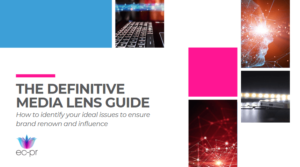
How to choose the right issues to build your brand reputation
How do you select the right topics to help build your B2B brand reputation, which journalists are interested in, and that resonate with your target audience? Here is our 4-step guide to kickstart your media relations in 2023 with a flourish.
Listen before you speak!
The old saying goes ‘You have two ears and one mouth – you should use them in that ratio.’ But how often do we find ourselves speaking more than we listen? It’s like entering a drinks reception and walking up to a bunch of people and talking about yourself before listening to what they are saying. Who does that? A good communicator reads the room first.
To be effective, this ‘listening’ needs to be undertaken after you have developed your communication strategy but ahead of any PR campaign delivery. This process will ensure you join the conversation at the right time and add something new so that others take note and listen. And, most importantly, your contribution will resonate with your target persona.
The process we use is called Media Lens.
What is the significance of media gatekeepers in building a reputation?
Not all communication with your target audience is direct. Media relations (earned media) rely on you successfully getting through a gatekeeper. Journalists are the gatekeepers. You need to get through the gate.
But, why? Firstly, they lend your organisation credibility, secondly, the journalist validates what you are saying so that your prospects trust you and finally, they raise awareness of your organisation amongst your target audience. The essence of a good reputation is trust, credibility, and authority – the media can provide all three.
In 2023 it’s no longer about a little black book bulging with media contacts, but that certainly helps! Journalists want new and unique insights and information that will engage their readers, views or listeners, they want news (opinion, announcements); issues not products and evidence such as whitepapers, case studies, reports, or surveys.
It’s important to remember, we are competing for journalists’ attention all the time. They can block and blacklist you if you are not relevant or interesting. You get one opportunity to make the right impression – you need to use it wisely.
1. Understand the competitive media landscape
Our bespoke Media Lens process explores current issues that your target media is interested in and writing about. It will successfully identify three issues which are relevant to your customers and that you are credible to talk about.
With your comms strategy in place, you need to identify whom you are competing with for attention. Our guidelines are designed to keep you focussed and make the project achievable.
Start by Googling your top three to five competitors.
Consider the first two pages on the news tab and make a note of what issues and comments are being reported. Look at how your competitors are describing themselves and what areas of expertise they claim to own. Document any campaigns or initiatives they are currently involved with and highlight what the media have said about them.
This will give you a clear picture of how your competitors are trying to position themselves and whether they have a successful strategy or not – and, importantly, it will reveal gaps and opportunities of which you may wish to take advantage.
2. Find your gatekeepers and identify the right issues
So, who are your gatekeepers? A key element of developing your target persona development was to identify where your target personas go for information. These information sources for each target buyer becomes your target media list, and the associated editors, reporters, analysts, and influencers are your gatekeepers.
Our sector pages are a good starting point.
Once identified, how do you choose a topic or two to speak about in an interesting way that will engage your gatekeepers? To decide which of your gatekeepers’ news storylines you should be engaging with, you need to start by reflecting on the big issues that have dominated the national business media and their relevance to your customer. These might include the skills gap, data/national/cyber security, sustainability, climate change, supply chain crisis, and global population migration.
Having considered the big picture, you go granular into your own industry, by doing the same exercise with your gatekeeper media list. Then finally, to help streamline the number of issues to six or fewer, you want to evaluate each issue in the context of:
3. Benchmark your issue ownership
Benchmarking where the market is on issue-ownership is critical to understanding both the scale and nature of the opportunity. You may want to own a topic, to be the thought leader, influencer, and considered expert whose opinion is sought out for comment, but what if that role is already filled by a competent, compelling, and engaging expert? It’s better to do the homework beforehand to identify meaningful gaps so you’re not disappointed further down the line and after investing a great deal of unnecessary and ineffective effort.
We do this through a media audit.
Start by assessing each main media source over the last six to 12 months – look for every occasion the news storyline is mentioned and capture who the spokespeople are and what they say including MPs, regulators, analysts, and industry company spokespeople – I.e., you and your competitors, and the source of the information e.g., a report, data, regulation.
In addition, the quantitative data you need to log is twofold – the total number of articles about each issue and a breakdown of each issue by competitive share of voice.
Yes, this is a number-crunching counting exercise. It’s labour-intensive and lacks any creativity, but the insight it provides makes the data trawling invaluable.
4. Choose your lighthouses, the news issues, you want to own
We talk about lighthouses because we want your messaging to shine like beacons in the dark, to stand out, and do an important job. The data you have collated needs to be reviewed by others in your organisation. You want a range of views when prioritising which issues to focus on for the year ahead. All six issues are important, but this is about prioritising three of them for the next 12 months.
To help you rank these issues, ask yourself and others:
|
Is it a current or emerging issue? |
Yes |
No |
|
Do you have a solid POV on the topic? |
Yes |
No |
|
Can you add to the conversation? Is there room for you? |
Yes |
No |
|
Do you have proof points or evidence to back up what you are saying? |
Yes |
No |
|
Could you create thought leadership content or a wider campaign? |
Yes |
No |
|
Is this an issue you want to be known for talking about? |
Yes |
No |
Following the above evaluation, you should be able to select three issues to work with that will feed into the wider B2B marketing communications plan and enable you to expand your Brilliant Ideas Bank and start your media relations outreach.
If you found this article valuable, you can get more useful B2B PR insight here. Download our comprehensive guide on how to choose the right issues to build your brand reputation: Your Definitive Media Lens Guide.
At EC-PR we are passionate about B2B communication. If you are serious about building your brand reputation through successful media relations, get in touch with our PR experts today.

Your definitive media lens guide
This PR guide provides a framework for B2B businesses to identify their sphere of maximum potential influence.



